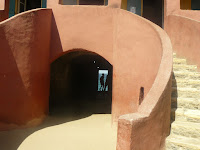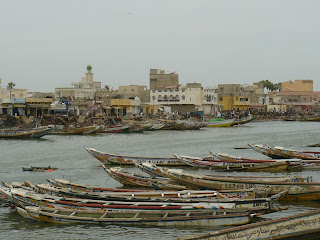Goree is a beautiful colonial town, now a UNESCO World Heritage Site, with a dark history. Every visitor to the island must see the former slave house, with its infamous Door of No Return, from where, it is said, many Africans last set foot on their native soil before being shipped to the Americas. How many passed through this prison is debatable, and many slaves held here were for Africa’s own market but, whatever the details, the building is now a museum to remind us of a deplorable chapter in history. It doesn’t require imagination to appreciate the appalling conditions in which people were held here and the displays leave one in no doubt.

Today Goree is a happier place with artists and artisans hoping to make a living from the increasing number of visitors. As we wandered its alleyways we were spoiled for choice in beadwork, sand pictures, textiles and paintings.
Leaving Goree and travelling north we reached the island city of Saint-Louis, another UNESCO World Heritage site, a picturesque town with its own darkness tucked away in its history. We encountered several groups of youngsters who spoke to us.
‘Education is very important to us,’ one young man told us in impeccable English having ascertained where we were from. ‘I intend going to university, then if I can raise the money I wish to study in England or America.’
‘What do you hope to study?’
‘To be a doctor to work here in my country,’ he replied. On learning that one of us was German, he addressed him in flawless German. He spoke five languages ‘…and a bit of Italian.’
Another young man, evidently less well off, told us that he too wanted to travel to England. His friend looked less enthusiastic but nodded in agreement.
‘They give you a job and a house there,’ he explained. We told him gently that it wasn’t quite as easy as that and encouraged him to stay in his own country until he too had got a bit more study under his belt. We were all aware of the disastrous journeys some youngsters undergo in the hope of reaching Europe.
But, as in many countries, the population of Senegal is becoming more urbanized and jobs are few. Education isn’t affordable for many and schools are underfunded. Our local guide, Baba, was passionate about education. He had set up a charity to help fund rural schools in Senegal and his native Gambia. ‘It’s the only way our countries can develop,’ he said. To access books children must learn French in addition to their native languages as relatively few books are provided in Wolof let alone the 34 lesser spoken local languages. Literacy rates in Senegal have increased in recent years and are currently around 55%.
The other chief cause of migration is the persistent desertification of Senegal’s Sahel regions. We passed an area of land being cleared of scrub.
‘It’s a development to grow tomatoes for the sun-dried tomatoes trade,’ Baba told us.
‘That’s encouraging, more local work,’ said one of the group.
‘The problem is,’ said Baba, ‘it’s not long term. The land is leased by an European country and while it will provide some work, the profits won’t be seen locally. The ground will be overused and exhausted leaving it too barren in later years for local people to work.’
Fortunately there are other more positive projects including The Great Green Wall that will hopefully flourish to improve the environment in the Sahel and job prospects for young people such as those we met.
I travel to learn more about a country as well as enjoying its geography and food – in Senegal it’s mostly delicious, especially the seafood.
‘What Senegalese books can you recommend?’ I asked Baba.
He answered promptly: ‘So Long a Letter by Mariama Bâ. It’s been translated into English,’ he added with a grin. He’d heard my attempts at French.
Other suggestions:
The Belly of the Atlantic by Fatou Diome
The Abandoned Baobab (The Autobiography of a Senegalese Woman.) by Ken Bugul
Thank you so much Lindsay for this fascinating look at Sengal.
About Lindsay Bamfield
Lindsay Bamfield has written a number of short stories and flash fiction pieces as well as non-fiction articles. She has been published in Hysteria 6 Anthology, Stories for Homes 2, Greenacre Writers Anthology, Mslexia, Writers’ News and Writing Magazine as well as on several websites. Prizes include Hysteria 2017, Great British Write Off 2106 and Words with Jam competitions.
She blogs on www.lindsaybamfield.blogspot.co.uk and is on Twitter @LindsayBamfield.






Lovely reading this and hearing about one of your many journeys. Love the book connection.
ReplyDeleteAn interesting snapshot of Senegal. How excited its people must be to be taking part in the World Cup... as we are The Bookish World Cup!
ReplyDeleteYou've made it sound just the place I'd like to visit! x
ReplyDeleteWhat a fascinating story!
ReplyDeleteNeed To Boost Your ClickBank Commissions And Traffic?
ReplyDeleteBannerizer makes it easy for you to promote ClickBank products by banners, simply go to Bannerizer, and grab the banner codes for your picked ClickBank products or use the Universal ClickBank Banner Rotator Tool to promote all of the ClickBank products.